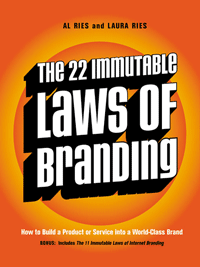 I’ve recently finished reading The 22 Immutable Laws of Branding. I liked it and have learned a few valuable lessons. Just want to share a few highlights–there is of course more to the book, but these are the things I found important and interesting.
I’ve recently finished reading The 22 Immutable Laws of Branding. I liked it and have learned a few valuable lessons. Just want to share a few highlights–there is of course more to the book, but these are the things I found important and interesting.
Focus
To create a strong brand you have to focus your offering. You have to be known for something–something that differentiates you from the rest of your competition. This means offering a consistent product line that focuses on that one thing.
For example, what do you think when you see Volvo? Safety. This is what they’re known for–it’s their brand’s selling point. What do you think when you see Ford? No idea, because Ford does everything. Releasing new products or product extensions that clash with your existing line dilutes the strength of your brand. If you want to expand, launch a new brand instead.
One word
What’s the one word that your brand is known for? What’s the word that’s associated with your brand name? In the above example, Volvo stands for safety. Rolex stands for luxury. Zappos is known for customer service. Identify a word that your brand will embody, and own it.
Quality
Quality doesn’t matter. What brand can you think of that’s associated with bad quality? Quality doesn’t matter very much because it’s not what separates your brand from the rest. Quality alone is a very weak differentiator because nobody else is selling bad products. Your brand means something other than this, whether it’s luxury, safety, user experience or customer service. Even if your product is weaker than that of your competitors, having a stronger brand can help you beat them in sales.
Naming
Pick a word that doesn’t try explain your product–make it up if you have to. A made up word is a blank canvas: it will be defined by your actions. Picking a descriptive name might work well in the short term, but in the long term all that separates your brand from the competition is the name. In a sea of bland names you have to stand out. Your name is not the product–it’s what the brand stands for.
Pick a name that’s short. Not just short in the number of letters, but short in the number of letters of the alphabet. Nissan changed its name from Datsun. Datsun is only 6 letters long, but its also 6 letters from the alphabet. Nissan is the same length, but only 4 letters of the alphabet–it’s simpler.
I saw a couple of A/B testing apps that have recently been launched. One is called Visual Website Optimizer. The other is called Optimizely. The descriptive name will work in the short term, especially with the SEO benefit. The shorter made-up name I think will end up winning the long-term. At least that’s the idea in the book. I’m not 100% sold on this as there are plenty of examples of successful brands with both types of names, but I do agree that a proper name is easier to brand than a common one since it’s more memorable and there are less prior associations to work with (or none if the word is completely made up).
Color
For your brand color, pick one that’s opposite to that of the market leader. If you’re new to the market, pick the one that symbolizes your product. Coca Cola was first. They picked red–a color similar to that of the product itself (dark orange/red liquid), and also a color that’s high in visual energy. Pepsi was second. They made a mistake by going with both blue and red at first. Lately they went blue, which is a great way to differentiate themselves from Coke.
If you don’t have first picks, you have to differentiate your brand from the leader. Going with the same color will make you a me-too product. Going opposite will help you stand out. If they have red, pick blue or green. If they have orange, pick purple. FedEx chose two strong colors: orange and purple–a sure way to stand out against a sea of corporate blue. Color itself doesn’t matter as much as differentiating yourself from your competition.
Market leader
Saying your product is the best (in any particular metric) is boring. Everyone says it, so it doesn’t mean anything. Stating that you’re the market leader is different–it’s a fact. People respect the market leader (they got there, so they must know something). It also simplifies purchasing decisions. Why buy the second best when you can buy the best? Just pick the leader.
Positioning your brand as the leader is an effective marketing tool. Of course you have to be a leader to do this. If you’re not, see if you can create a new market category, and dominate that instead. If you can’t be the leading beer, see if you can be the leading light beer, the leading imported beer, the leading microbrew, the leading ice beer, the leading high-priced beer, and so on…
Summary
The biggest take away from the book is that of contraction. If you contract your offering and focus it more and more on something, your brand will gain strength. It will be known for something, it will become the leader in something. If you expand, your brand will dilute–it will become weak. It will stand for everything, and thus stand for nothing.